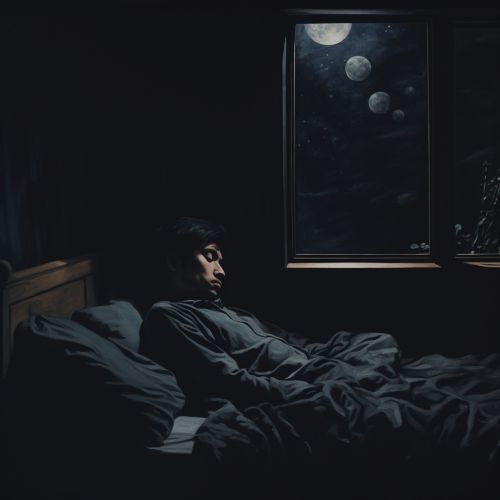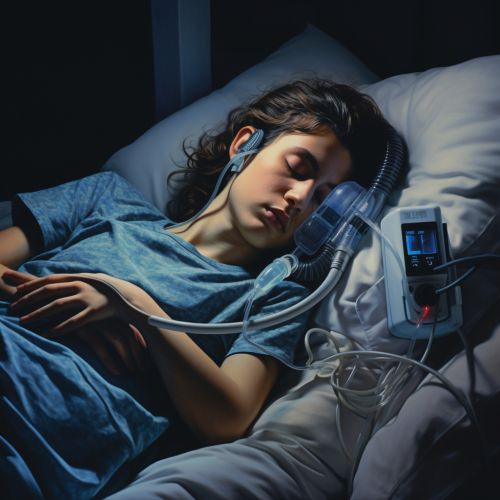Sleep disorders
Overview
Sleep disorders, also known as somnopathies, are conditions that affect the ability to sleep well on a regular basis. These disorders can be caused by a variety of factors, including physical, mental, and environmental issues. They are characterized by disturbances in a person's quantity, quality, or timing of sleep, or in behaviors or physiological conditions associated with sleep[1].


Classification
Sleep disorders are broadly classified into six main categories: insomnia, sleep-related breathing disorders, hypersomnolence, circadian rhythm sleep-wake disorders, parasomnias, and sleep-related movement disorders[2].
Insomnia
Insomnia is the most common type of sleep disorder. It is characterized by persistent difficulty falling asleep or staying asleep, despite having an adequate opportunity to sleep. This results in daytime sleepiness, low energy, irritability, and a depressed mood[3].


Sleep-Related Breathing Disorders
Sleep-related breathing disorders, such as sleep apnea, are characterized by abnormalities in respiratory pattern or the quantity of ventilation during sleep. This can lead to frequent awakenings during the night and excessive daytime sleepiness[4].


Hypersomnolence
Hypersomnolence, also known as excessive daytime sleepiness, is characterized by recurrent episodes of excessive daytime sleepiness or prolonged nighttime sleep. This disorder can be caused by other sleep disorders, medical conditions, medications, or lifestyle factors[5].


Circadian Rhythm Sleep-Wake Disorders
Circadian rhythm sleep-wake disorders are a group of sleep disorders that result from a misalignment between the timing of a person's internal biological clock and the external environment. This can lead to insomnia or excessive sleepiness at inappropriate times[6].


Parasomnias
Parasomnias are a group of sleep disorders that involve unwanted events or experiences that occur while you are falling asleep, sleeping, or waking up. They include nightmares, night terrors, sleepwalking, confusional arousals, and many others[7].


Sleep-Related Movement Disorders
Sleep-related movement disorders are characterized by simple, often repetitive movements during sleep. They include restless legs syndrome, periodic limb movement disorder, and sleep-related bruxism (teeth grinding)[8].


Diagnosis
Diagnosis of sleep disorders usually involves a thorough medical history and a physical examination. In some cases, an overnight sleep study at a sleep clinic may be recommended. This study, called a polysomnogram, records brain activity, eye movements, heart rate, blood pressure, oxygen levels, body movement, and more[9].
Treatment
Treatment for sleep disorders can vary depending on the type and underlying cause. It often involves a combination of medical treatments and lifestyle changes. Medical treatments may include medications, breathing devices or surgery (for sleep-related breathing disorders), and dental devices (for sleep-related bruxism). Lifestyle changes may include improving sleep hygiene, cognitive behavioral therapy for insomnia, and chronotherapy for circadian rhythm sleep-wake disorders[10].
See Also
- Insomnia
- Sleep apnea
- Hypersomnia
- Circadian rhythm sleep-wake disorders
- Parasomnia
- Restless legs syndrome
References
- ↑ https://www.ncbi.nlm.nih.gov/books/NBK279320/
- ↑ https://www.ncbi.nlm.nih.gov/books/NBK279320/
- ↑ https://www.ncbi.nlm.nih.gov/pmc/articles/PMC2924526/
- ↑ https://www.ncbi.nlm.nih.gov/pmc/articles/PMC2817918/
- ↑ https://www.ncbi.nlm.nih.gov/pmc/articles/PMC2579975/
- ↑ https://www.ncbi.nlm.nih.gov/pmc/articles/PMC2924526/
- ↑ https://www.ncbi.nlm.nih.gov/pmc/articles/PMC2924526/
- ↑ https://www.ncbi.nlm.nih.gov/pmc/articles/PMC2924526/
- ↑ https://www.ncbi.nlm.nih.gov/pmc/articles/PMC2817918/
- ↑ https://www.ncbi.nlm.nih.gov/pmc/articles/PMC2924526/
